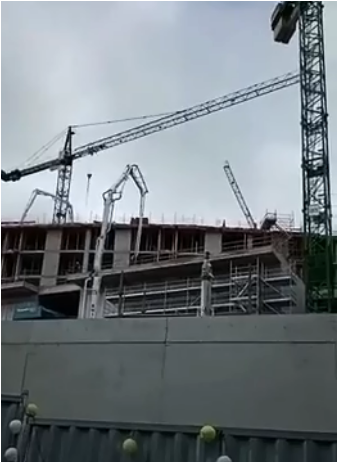Monitoring
There are two elements that make up the monitoring of the New Children's Hospital; the first is the Residents Project Monitoring Committee and the monitoring regime its role and the minutes of meetings are listed below and the second are the Monitoring Reports that are produced every 6 weeks on Dust, Noise and Vibration outputs from the site.
In 2022 the independent reporting by Atkin's on dust, noise and vibrations were suspended due to the advanced state of the development. However monitoring will return for the building work yet to be done including the Family Accommodation Unit and the CRIC buildings.
The 24/7 residents hotline to report issues, disturbances or breaches of workings hours has ceased operation. If members of the public have any concerns that they wish to raise with BAM they should contact Site Senior Security Officer Derek 0876967723 or contact BAM through Chloe McHugh cmchugh@bam.com
Use the links below to get around the page
Residents Project Monitoring Committee Other issues |
Feedback to BAM
Feedback to NPHDB
Residents Feedback procedure here
The Role of the Residents Monitoring Committee
The new children’s hospital Residents Monitoring Committee is to develop a process for communication and dialogue and to manage and address residents’ concerns and issues during the construction phase of the project and work as a collaborative group to mitigate and resolve these issues.
Primary Objectives of the Monitoring
- Serve as a two-way communication channel between NPHDB and local residents/representatives on the construction of the new children’s hospital
- Frequency of meetings should be at least monthly until full construction is underway to ensure process is agreed
- Provide timely information to the Group on upcoming construction works and likely impact
- Provide a forum for open discussion and reporting on matters concerning construction impacts. These would include issues such as noise, vibration, traffic, dust, working hours, timelines etc and the effectiveness of any construction mitigation measures
- Agree monitoring and reporting templates
- Agree material and communications protocol (meetings, web page, social media app etc) for circulation to wider audience
- Develop a forum to resolve issues/conflicts in a timely and collaborative manner
- Ensure that impacts have been mitigated properly to the agreement of local residents
Members of the RMC
Chair Mr. Peter Finnegan, Independent
Nominated local residents representatives Mr. Daniel Watkins, South Circular Road, Jean Early Ceannt Fort, Mr. George Ray, Ceannt Fort ,Siobhán Geoghegan Rialto Residents
Named local residents replacement representatives, Mary Kearney SCR, Brenda Meehan OReilly Ave Residents, Damien Farrell 4 Tces Residents .
Dublin City Councillors Cllr Tina McVeigh (People Before Profit), Cllr Maire Devine(Sinn Fein)Cllr Darragh Moriarty (Labour),
Dublin City Council Executive Bruce PhillipsSouth Central Area
National Paediatric Hospital Development Board Executives Mr.Phelim Devine, Project Director Ms. Rhonda Evans, Communications Manager
BAM Chloe Mc Hugh BAM Manager for Community Benefit and Community Liaison, Tadhg Kelly BAM Director of Construction
Administrator Ms. Elaine O’Rourke (NPHDB)
Project Committee Technical Advisor Atkins Global, AJ Browne
Community Facilitator Billy Murphy
2024
NCH Residents Monitoring Committee April 24
2023
NCH Residents Monitoring Committee Nov 23
NCH Residents Monitoring Committee June 23
NCH Residents Monitoring Committee March 23
2022
NCH Residents Monitoring Committee Nov 22
NCH Residents Monitoring Committee Sept 22
NCH Residents Monitoring Committee March 22
2021
NCH Residents Monitoring Committee Nov 21
NCH Residents Monitoring Committee Sept 21
NCH Residents Monitoring Committee July 21
NCH Residents Monitoring Committee April 21
NCH Residents Monitoring Committee Feb 21
NCH Residents Monitoring Committee Jan 21
2020
NCH Residents Monitoring Committee Nov20
NCH Residents Monitoring Committee Oct 20
NCH Residents Monitoring Committee Sept 20
NCH Residents Monitoring Committee Aug 20 amendments due
Action Points Aug 20
NCH Residents Monitoring Committee draft July 20
NCH Residents Monitoring Committee March20
NCH Residents Monitoring Committee (draft) Jan20
2019
NCH Residents Monitoring Committee Jan19
NCH Residents Monitoring Committee March19
NCH Residents Monitoring Committee April 19
Minutes Residents Monitoring Committee May 19
Draft minutes NCH Residents Monitoring Committee June 19
July meeting cancelled e ( A non formal meeting )
Draft minutes NCH Residents Monitoring Committee 12 Sept 19
Draft minutes NCH Residents Monitoring Committee OCT19
Draft minutes NCH Residents Monitoring Committee Nov 19
Draft minutes NCH Residents Monitoring Committee Dec19
2018
Draft minutes NCH Residents Monitoring Committee 25-01-18
Action Points from Residents Monitoring Committee 25-01-18
Draft minutes NCH Residents Monitoring Committee 08-03-18
Action Points from Residents Monitoring Committee 08-03-18
Minutes Residents Monitoring Committee April 18
Draft minutes NCH Residents Monitoring Committee 24-05-18
Action Points from Residents Monitoring Committee 24-05-18
Draft minutes NCH Residents Monitoring Committee 21-06-18
Action Points from Residents Monitoring Committee 21-06-18
Minutes Residents Monitoring Committee Aug 18
Draft minutes NCH Residents Monitoring Committee Oct 18
Action Points from Residents Monitoring Committee Oct18
Draft minutes NCH Residents Monitoring Committee Dec 18
2017
Minutes - NCH Residents Monitoring Committee 26-01-17
Enabling Works Report for January end 2016
Minutes - NCH Residents Monitoring Committee 02-03-17
Minutes - NCH Residents Monitoring Committee 27-04-17
Minutes - NCH Residents Monitoring Committee 01-06-17
Action Points from Residents Monitoring Committee 01-06-17
O'Reilly Avenue Residents Group representative in attendance due to issues in relation to adverse impacts on houses as a result of enabling works
Minutes - NCH Residents Monitoring Committee 20-06-17
Action Points from Residents Monitoring Committee 20-06-17
Minutes - NCH Residents Monitoring Committee 20-07-17
Action Points from Residents Monitoring Committee 20-07-17
Minutes NCH Residents Monitoring Committee 07-09-17
Draft minutes NCH Residents Monitoring Committee 05-10-17
Draft minutes NCH Residents Monitoring Committee 23-11-17
Action Points from Residents Monitoring Committee 23-11-17
2016
Minutes – NCH Residents Monitoring Committee 29.11.16
Minutes – NCH Residents Monitoring Committee 15.12.16
Monitoring System
As part of the impact monitoring process BAM have a number of monitoring systems in place that are independently administered and monitored.
As part of the build, at the outset base line was collected on a number of houses adjacent to the site deemed to be front line residences in terms of possible impact during the Site Preparation and a number of additional residences have been added to the original group as part of the Construction phase of the project.
The houses covered in the solid red line are the houses included in the original survey and the house covered in the lighter red are the houses added as part of the main construction phase. Essentially all adjacent residents have surveys of their homes completed against which all subsequent claims of damage can be compared with. Currently a protocol of "How a Claim is processed " is been agreed between Atkins the Residents Technical Advisors and NCH, the protocol is based on an actual resolution that was completed in December 2018.

As well as the base line data collected on houses, a series of monitors are located on the site boundary to collect information on dust and vibration/noise levels.
Original Construction Management Plan Appendices
| Appendix d | Dust Minimisation Plan | |
| Appendix e | Noise and Vibration Management Plan | |
The requirement for Dust Monitoring on site is laid out in the Project Environmental Impact Statement (EIS) that would have been submitted as part of the Planning Permission for the project. A number of monitoring points around the perimeter of the site are used to record dust levels.
The monitors are examined monthly and the levels of dust recorded are compared to a dust limit of 350mg / m2 / day- Noise 70dB set out in the Project EIS. The monitoring points are monitored on a 'trigger level' basis - so if a predetermined level of dust/noise is exceeded the Main Contractor shall review work processes and modify as required to reduce the level of dust/noise generated.
The location and number of monitors may vary throughout the project depending on activities on site, the location of monitors/sensors are listed in each report below for the period of time being reported.
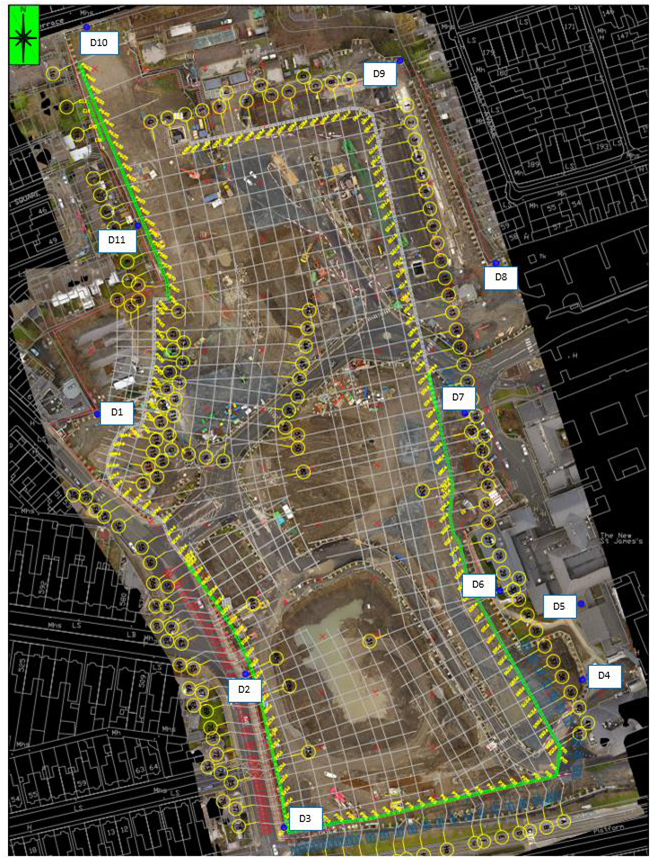
Please Note that the locations above are indicative locations, for the precise location of sensors/monitors, please check the actual report by date below.
Check out AIR Quality Environmental Protection Agency (EPA)
What is the Air Quality Index for Health?
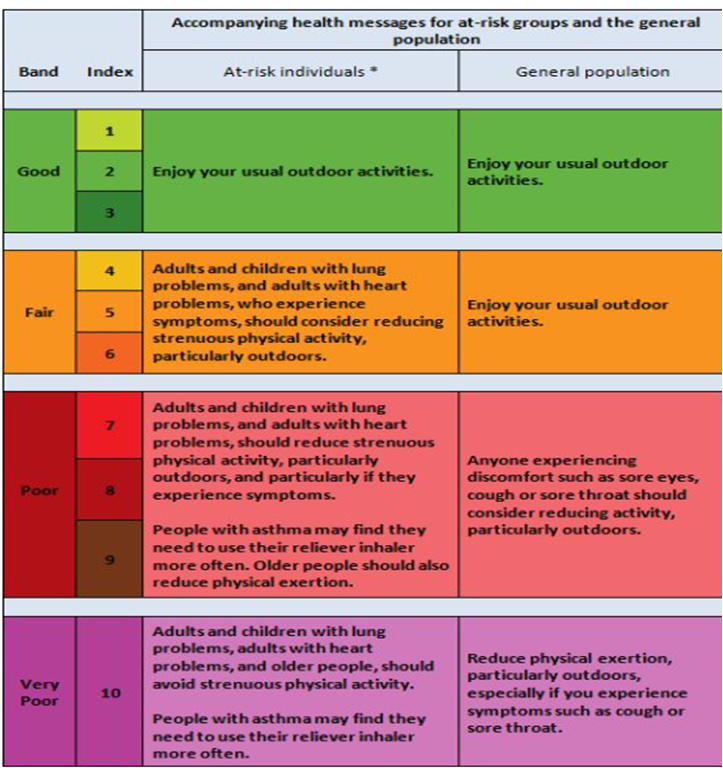
The Environmental Protection Agency's Air Quality Index for Health (AQIH) is a number from one to 10 that tells you what the air quality currently is in your region and whether or not this might affect the health of you or your child. A reading of 10 means the air quality is very poor and a reading of one to three inclusive means that the air quality is good. The AQIH is calculated every hour.
Noise Monitoring.
During the report period noise monitors have been placed at the ‘closest part of sensitive property’
as per the Project EIS where this has been feasible, or alternatively to the outside face of the site
hoarding. When works are ongoing the noise monitor sensors run continuously and readings are
recorded in decibels (dB) LAeq1hr. Decibels is the standard unit of measurement of sound energy and
‘LAeq1hr’ means that sensors record all levels of sound over a 1 hour period and then calculate an
average equivalent decibel level as if the sound was continuous. Isolated instantaneous loud noises
are thus averaged out.
The Project Environmental Impact Statement (EIS) that was part of the project Planning Permission
established a noise limit at residential dwellings of 70dB LAeq1hr. Site operations are monitored using
a traffic light trigger system of Green, Amber and Red trigger levels with the Red trigger level set at
the noise limit set out in the project EIS (70 dB LAeq1hr.). Any noise level recorded below Red levels
is acceptable within the limits established in Planning.
Number of Noise Monitors on Site: There are up to 16 monitors on the site as parting of the reporting to residents a number of monitors are not reported on as they are deemed not to impact on residents.
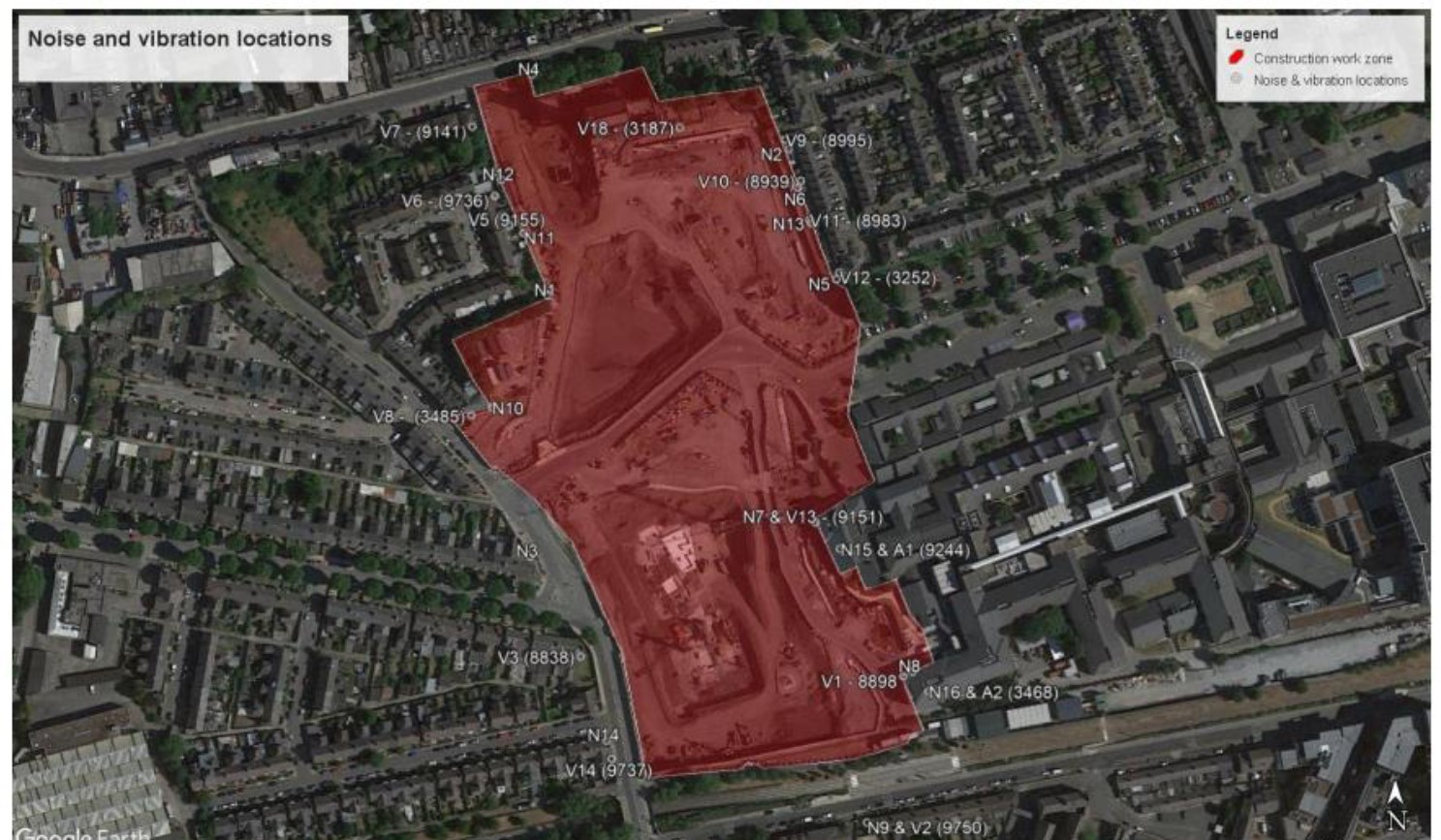
There are 4 of the 12 monitors that are reported on, that are consistently breaking the planning level permitted 70dB these are located at Mount Brown (N4), at the MACE shop on SCR(N3) and at the top of Mountshannon Rd (N14)and the final monitor is on James Walk,(N9). This monitor has already been relocated from the Luas Stop because it was constantly exceeding the level permitted.
It appears that traffic noise is the cause of these high levels as they often occur after work hours and over the weekend when there is not site activity. The 2017 DCC Noise Map below does show that 3 of the 4 monitor sites do have sub 70 noise levels.
EU Noise Pollution
Under EU Directive 2002/49/EC transposed by SI number 140 of 2006, Environmental Noise Regulations 2006, the four local authorities, within Dublin (Dublin City Council, Fingal, Dun Laoire Rathdown and South Dublin County Councils), are required to produce ‘Maps’ for noise emanating from major Industry and transport. This Directive was implemented on foot of an EU Green Paper on ‘Future Noise Policy’, which highlighted the need for a high level of health and environmental protection against noise. In the Green Paper, the Commission addressed noise in the environment as one of the main environmental problems in Europe.
Noise Map
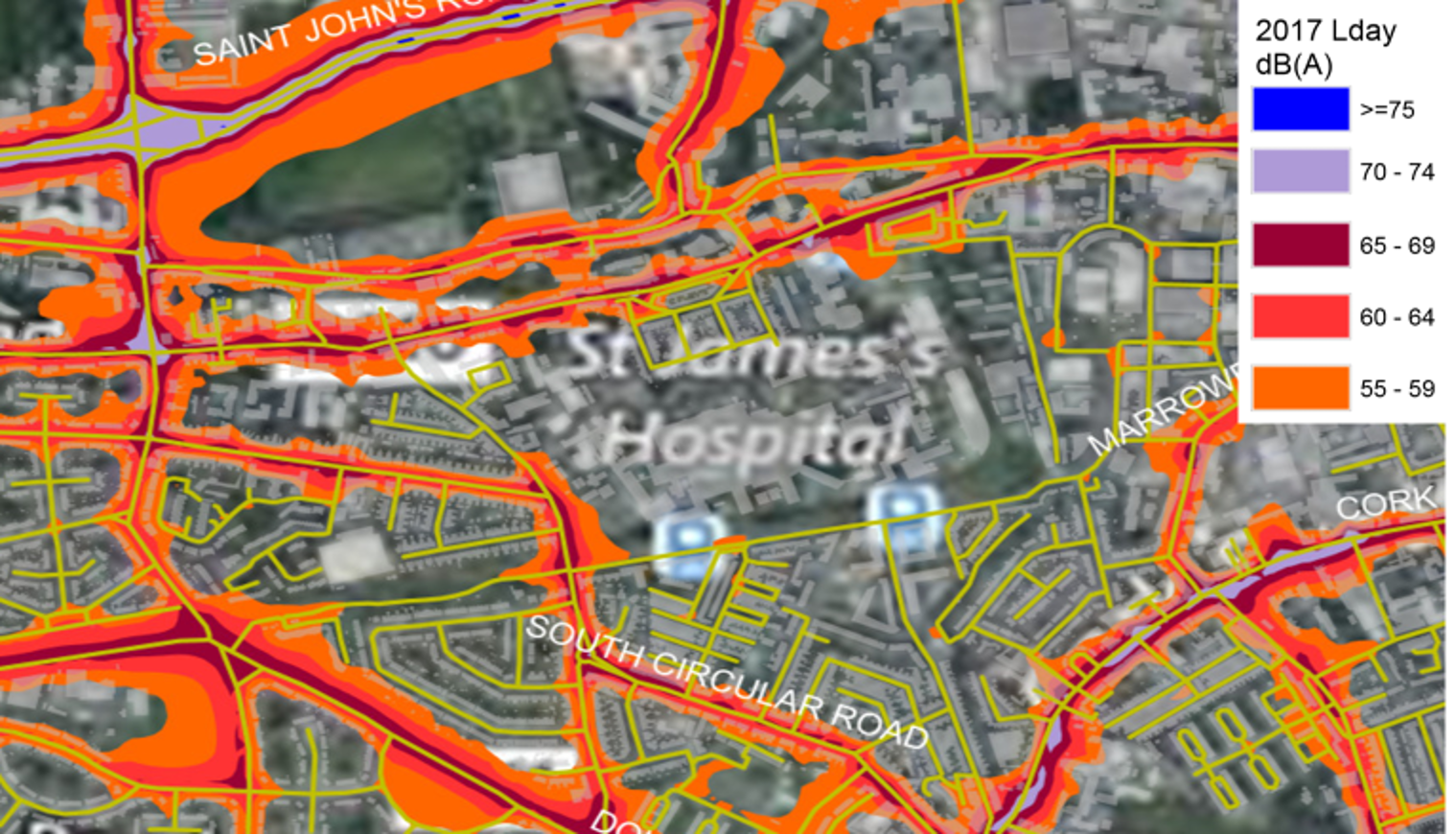
Monitoring Reports made available to Residents
The monitoring is carried out by contractors and the data is made available to Atkin Global the residents technical advisors, to interrupt and then present that data in a accessible format for the public , these reports are listed above.
"Vulnerable groups of people, including those with long-term illnesses, those sensitive to noise or tinnitus (ringing of the ears), people with mental health problems and unborn and newly born babies, are often more susceptible to physical and emotional stresses. So, vulnerable groups of people may be more at risk from exposure to environmental noise than healthy adults, say researchers after reviewing the health impacts."
Science for Environmental Policy THEMATIC ISSUE: Noise impacts on health Environment
Check out RESOURCES for other reports and resources
BAM are to introduce a new dust management system. The RPMC were informed that the supplier has been agreed and the system should be operational in the coming weeks.
Why BAM have replaced their dust suppression system is unclear, certainly the system in place never exceeded the limits set by the Planning Permission unlike the noise and vibration monitors. Indeed the highest dust reading for May was 65% of the permitted level. However it is welcomed that the system in place is being changed because regardless of the “acceptable levels “ the clouds of dust that covered the streets and our homes was becoming unacceptable and raised questions about the air quality in and around the boundary of the site.
The new system presented at the June 2018 RPMC meeting is outlined below.
For ORA a fixed pipeline with pressure storage tank and 5 rain guns automatically activated by moisture sensors will be linked into the site ground dewatering system.
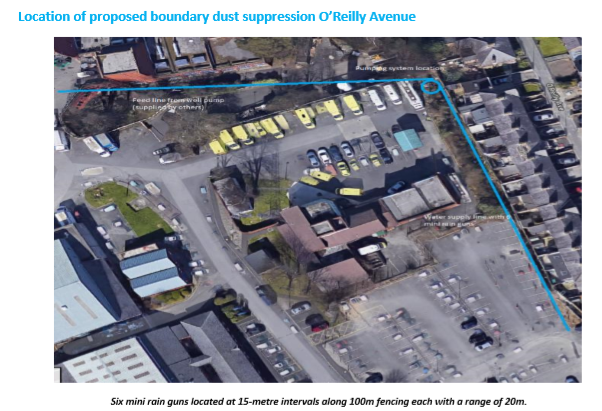
Shortly the surfaced temporary road will be completed on the Utility Tunnel along ORA and works will be move further away from ORA. We will then use dust suppression gel additive to the potential dust areas and relocate the rain gun system to Cameron Square if determined to be no longer required along ORA.
Along Cameron Square a piped rain gun system with moisture sensors cannot be installed until the capping beam works have been completed and it is intended that a mobile bowser tanked rain gun system is used in the interim to control any potential dust generation along Cameron Square. The piped rain gun system along ORA will later be relocated to Cameron Square when no longer required on ORA
.TOP
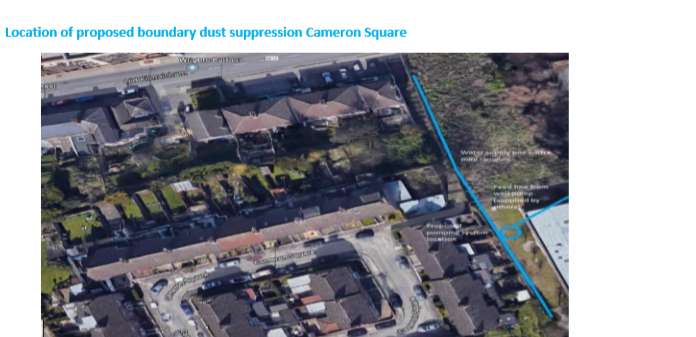
For the SCR/Linear park and Hospital 7 areas BAM will be installing a pipeline along the capping beam with outlets every 20m that will permit hand spraying of the site with the capping beam enclosure.
All systems will be supplied from the groundwater system to prevent using DCC water supplies and to minimise discharge of groundwater through the DCC sewer system. This is particularly relevant considering the Irish Water hose ban.
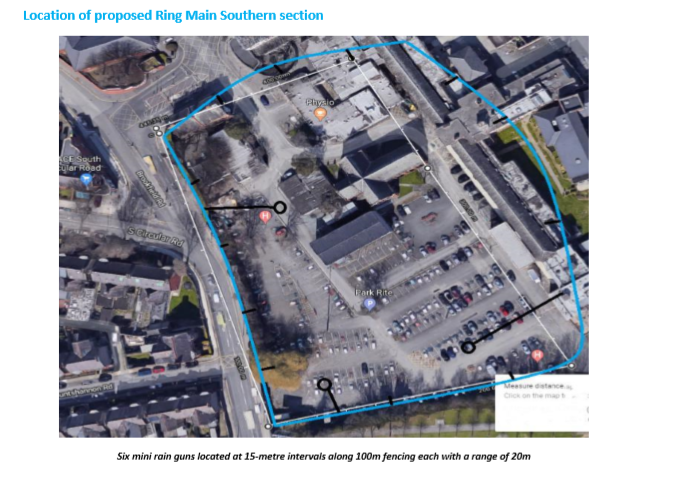
Movement Monitoring November 2017
As part of the main building works, BAM is establishing a monitoring network around the site. This involves the placement of prisms (image below) on a number of selected properties located on the roads and streets in the vicinity. This network of prisms will provide a number of three dimensional monitoring reference points that will be regularly surveyed to check for any movement. These monitors are fixed to the wall using adhesive and access to a height will be by ladder. These monitors are surveyed by instruments on a regular basis from within the NCH site to determine if any movement is occurring. The measuring devices are being connected to a number of "control" house around the site.( More)
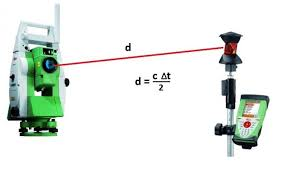
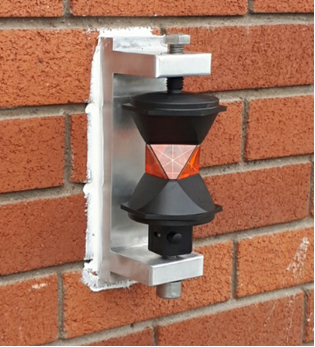
Some 800 lorry journeys are made weekly along the SCR and onto Suir Road from the NCH site . The impact on road along the transit route is apparent for all to see, in terms of the damage to the road itself in a number of locations, the constant dirt being thrown up on cars on a daily basis and with dirt and muck accumaling on footpath and being walked into people homes has caused much anger among residents. (See survey findings)
Under the EIS all lorries leaving the site, must have their loads covered and have gone through a wheel wash to ensure that dirt from the site is minimised.
The system is self monitored by BAM and breaches of rules are conveyed to the contracting supplier, up to this point McGuire but increasingly changing to road stone.
The McGuire Haulage disciplinary procedure for truck drivers is they get two verbal warnings (yellow cards) followed by a red card for a third infringement which means they will be removed from working on this site. When an infringement (e.g. no cover, unwashed wheels) is reported to BAM by a member of the public BAM check the log, identify the truck and driver and report the matter to McGuires who investigate and deem if implementing disciplinary procedure is warranted.
"checking the log " BAM check out all lorries leaving the site so wheels covers etc are confirmed or if not noted.
One of the realities of the construction of the New Children's Hospital is the pivotal role that Dublin City Council play not only in the direct construction of the hospital itself in terms of planning and planning enforcement but also in the peripheral items which can and do impact on communities living around construction sites, such as parking, cleaning, road maintenance and traffic management.
The importance of the DCC is reflected in the composition of the Residents Monitoring Committee with elected councillors and South Central Area staff on board, however what has become evident during the last 12 months is the complex and to the outsider the apparent lack of co ordination between DCC services in terms of delivery on the ground.
Although South Central Area staff are on the RPMC not all DCC activities that occur in the South Central Area are communicated with the Area office, road works being a prime example but in addition traffic and parking which are key issues in the areas adjacent to the hospital are not communicated through the South Area Office similarly for the Parks Department, all of the activity on the Linear Park was conducted between St James Hospital and DCC Parks and the South Central Area were not necessarily part of these discussions.
From the outset of the monitoring process the resident representative on the RPMC have looked for information on DCC local services and relevant points of contact. The items requested were varied but included a web link through the DCC Web site to all public planning information on the NCH , this has not happened although the Planning Enforcement Section did provide a copy the BAM Construction Management Plan( Link here ) however the time line outlined in the documentation ceased in December 2017 and any attempt to get an update on the plan has been unsuccessful.
- A list of all DCC sections and contacts in those sections with responsible for services in areas adjacent to NCH including Roads and Traffic and Parks
- A meeting with all sections whereby some system of communication could be established whereby the South Central Area Office are notified of all DCC or DCC managed activities and the relevant activities that impact on the communities around the hospital can be notified to the Resident Representatives.
- Links to relevant planning sections on DCC Web Site
- All planned road maintenance out of hours work would be notified in residents in advance of the work occurring, even in the case of emergency work there is a significant amount of this which is planned in advance and residents can be notified.
- Agreement of a set of Building Protocols for the area be agreed by DCC and applied across the area.
- Sight of the DCC Traffic Management Plan for the Hospital area
South Central Area
The South Central Area is one of 5 administrative areas used by Dublin City Council to co-ordinate the delivery of services in the city. The area has a population of approximately 105,000 and is located in the south-west quadrant of Dublin City, south of the Liffey and stretching from Lower Kimmage Road / Sundrive Road/Clogher Road to Chapelizod. It has many well established communities and neighbourhoods including the Liberties, Inchicore, Chapelizod, Ballyfermot, Bluebell, Drimnagh, Rialto, Crumlin and Walkinstown.
South Central Area Committee minutes and meetings you can also access the WEB cast for the same meeting here and follow the links for South Central Area Committee.
Construction and Demolition Protocols
Dublin City Council issued a protocol " To alleviate / mitigate the issues currently being raised by residents in the Docklands Area". The protocol occurred as a result on continuing breaking of agreements in relation to noise and dust and are based on protocols in London. It is now proposed that these protocols will apply to all inner city Dublin sites including the NCH site.
The protocols which are available HERE will certainly bring some comfort to residents in terms of what is and what is not acceptable practice. Obviously the adequate washing of wheels will have an immediate benefit but also the receiving of monitoring data every two rather than the four weeks currently in application on the NCH site (although in reality it is between 6 to 10 weeks which renders the results useless)
